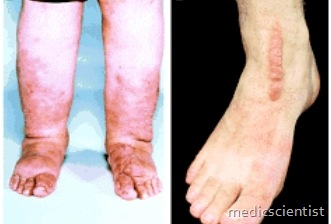Article Contents ::
Myxedema coma
- This is a state of hypothyroidism with altered consciousness or coma, sometimes seizures. There may be hypothermia.
- It is common in the elderly, and precipitated by seda-‘ tives, antidepressants, pneumonia, CHF, MI, cerebrovascular accidents.
- marked by neurological dysfunction, by respiratory depression, and by lowered body temperature, blood pressure, blood sugar, and serum sodium.
- System(s) affected: Endocrine/Metabolic
- These patients may be hypoxaemic, hypercapneic, hyponatremic, hypoglycemic.
Myxedema coma Risk Factors
- History of Graves disease
- Increasing age
- Personal or family history of autoimmune diseases, including type 1 DM, Addison disease
- Previous head or neck irradiation
- Previous postpartum thyroiditis
- Treatment with lithium, immune modulators such as IFN-, or the iodine-containing antiarrhythmic amiodarone
Myxedema coma DIAGNOSIS —
- The diagnosis of myxedema coma is initially based upon the history, physical examination, and exclusion of other causes of coma
Myxedema coma Initial Lab Tests
- •Primary hypothyroidism
- Serum free T4 decreased
- TSH elevated
- •Central hypothyroidism:
- Impaired TSH response to TRH
- Serum free T4 decreased
- TSH low
- •Severe hypothyroidism:
- Hyponatremia
- Elevated CPK, LDH, AST
- Elevated cholesterol
- Anemia
- •Subclinical hypothyroidism:
- TSH elevated
- Serum free T4 normal
Myxedema coma Treatment
- Levothyroxine-single IV bolus 500 mcg loading dose then 100 mcg/day. Levothyroxine may be given by nasogastric tube as crushed tablets.
- Patient is kept warm.
- Hydrocortisone IV 50 mg 6 hrly is given. Broad spectrum antibiotics for infection. Hypertonic saline and IV glucose.


